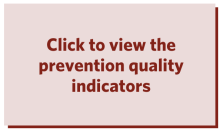The prevention quality indicators are a set of measures which, when combined with hospital in-patient discharge data, reveal meaningful information about the quality of care for ambulatory sensitive conditions. These are conditions for which good outpatient care or early intervention can prevent hospitalisation, complications or more severe disease. Put simply, low is good. While zero may not be achievable, the ideal rate for these fourteen prevention quality indicators is as low as possible.
While based on hospital in-patient data, these indicators give insight beyond just a secondary care context as the point of early detection often sits within community and primary care. For example, patients with diabetes may be hospitalised for diabetic complications if their condition is not adequately monitored or if they are not given enough information for appropriate self-management outside of hospital.
The prevention quality indicators can be used to identify unmet needs within community based care, show resource variation across DHB regions, and clearly outline opportunities for quality improvement within community, primary and secondary care settings.
The indicators
The data shows the rolling 12-month crude admission rate for each of the fourteen indicators. For simple data analysis, we created a distinct page using SAS coding which allows for quick downloading by district health board (DHB) analytic teams.
The listed indicators* are:
- PQI 01 Diabetes Short-term Complications Admission Rate
- PQI 02 Perforated Appendix Admission Rate
- PQI 03 Diabetes Long-term Complications Admission Rate
- PQI 05 COPD or Asthma in Older Adults Admission Rate
- PQI 07 Hypertension Admission Rate
- PQI 08 Heart Failure Admission Rate
- PQI 09 Low Birth Weight Rate
- PQI 10 Dehydration Admission Rate
- PQI 11 Bacterial Pneumonia Admission Rate
- PQI 12 Urinary Tract Infection Admission Rate
- PQI 13 Angina Without Procedure Admission Rate
- PQI 14 Uncontrolled Diabetes Admission Rate
- PQI 15 Asthma in Younger Adults Admission Rate
- PQI 16 Lower-Extremity Amputation Diabetes Rate
The background and why they’re relevant
The prevention quality indicators were originally developed by the Agency for Healthcare Research and Quality (AHRQ) and later endorsed by the National Quality Forum. These are part of a larger set of quality indicators developed by the AHRQ which are widely used in the United States of America for research, health care planning, quality improvement and reporting initiatives. These have now been translated to the New Zealand context by the Health Quality & Safety Commission with assistance from the Ministry of Health.
Many of the Commission’s quality and safety markers, which make up the backbone of our quality improvement programmes, are based on AHRQ indicators that were then translated into the New Zealand context. It is possible that any one of these prevention quality indicators may turn into a future quality improvement project, perhaps supported by us here at the Commission, or locally supported through your organisation’s analytic and quality improvement teams.
These measures are also potentially relevant to the acute hospital bed day system level measures.
The intention of this site is to provide a secure platform for you and your DHB to explore the quality of your health care with the ability to improve it – and know you can trust the data and methodology behind the crude rates. Admittedly, what we are doing here is not necessarily difficult, but it does take time. We hope that by doing the upfront work, local analysts can use their time more effectively, with less time on data prep and more time on analysis and improvement.
The methodology
For this test website, all indicators were calculated based on quarterly extracts from the National Minimum Dataset. Diagnosis and procedure codes have been translated from ICD-9-CM to the New Zealand-specific ICD-10-AM 6th and 8th edition.
- View the original descriptions of each indicator from the AHRQ or download the original indicators as a ZIP file (ZIP 1.3 MB).
The translated ICD-10-AM diagnosis and procedure codes are available as a Microsoft Excel file. The table shows the original indicator from the AHRQ and the translated version.
Our data shows the rolling 12-month crude admission rate for each of the 14 prevention quality indicators.
Please email qis@hqsc.govt.nz with any questions, comments and suggestions about the indicators.

